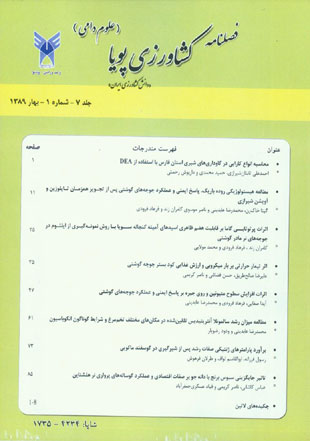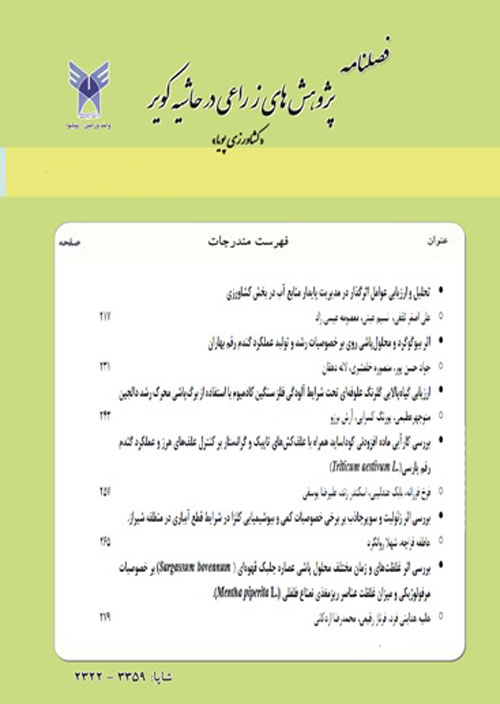فهرست مطالب

فصلنامه پژوهشهای زراعی در حاشیه کویر
سال هفتم شماره 1 (بهار 1389)
- 110 صفحه،
- تاریخ انتشار: 1389/02/22
- تعداد عناوین: 8
-
Page 1Objective of this study was to estimate different kinds of efficiency in dairy farms of Fars province, using data envelopment analysis (DEA) approach.The data applied to study was obtained through completing 100 questioners among a randomly selected sample of dairy farms. The results showed that Scale and technical efficiency of the sample were 0.85 and 0.6 on average, respectively. Scale efficiency was obtained for 22 heads farms indicating a higher profitability as compared to other sizes of farm. As well as efficiency of scale is most dairy ascending.Keywords: Efficiency, Dairy Farms, DEA Approach, Fars Province
-
Page 11This experiment was conducted to evaluate the effect of Zataria multiflora (ZM) and Tylosin antibiotic on immunity response and intestinal morphology in broiler chicken. The experiment was performed with six treatments and four litter pen repeats by using 480 Ross 308 broiler chickens in a complete randomized design study. Each litter pen had 20 chickens. In this experiment we used two levels of Tylosin and three levels of ZM. The treatments included the oily extract of Zataria multiflora in the three levels (0, 1 and 2 g/kg) and Tylosin phosphate(25%) in the two levels (0 and 200 mg/kg) in the chicken feed of six treatments.In the evaluation of antibody titer in the 13 day old chicks no significant interaction effect of ZM and Tylosin was found. There was no significant effect on feed conversion ratio (FCR) and weight gain in whole periods. In the evaluation of different levels of ZM, treatment containing 2 g/kg rather than level 0 significantly reduced feed intake. In the various periods, addition of ZM and Tylosin had no significant effect on the FCR and level 200 mg/kg Tylosin × 2 ZM was better than 0 mg/kg Tylosin×2 ZM (p<0.05). In the other treatments there was no difference. The simultaneous use of ZM and Tylosin in the different levels also had no significant effect on the weight gain (p>0.05). In evaluation of the effect of ZM and Tylosin at different levels separately, the length of intestine villi, increased by the level zero of ZM. Also in zero level of Tylosin the length of villi significantly increased rather than level 20 of Tylosin. In evaluation of the interaction effect of ZM and Tylosin on the length of intestine villi, the treatment 1 ZM×0 Tylosin had more effect rather than treatments 1 ZM×200 Tylosin and 2 ZM×200 Tylosin with greater length of villi (p<0.05). In considering three levels of ZM, the level 1 increased villi width significantly but Tylosin levels did not affect villi width alone. In the treatment 1 ZM×0 Tylosin, rather than the treatment 2 ZM×200 Tylosin, the width of the villi was greater, but had no significant difference with the other treatments. In considering the interaction effect of ZM and Tylosin there was no significant effect of above treatments on the depth of crypts (p>0.05).Keywords: Zataria multiflora, Tylosin, Broiler Performance, Immunity, Intestinal Morphology
-
Page 25The objective of this study was to investigate the effect of different doses of Gamma irradiation on the apparent ileal digestibility in male broiler breeders of amino acid from soybean meal. Samples were irradiated in a Gamma cell at total doses of 15, 30 and 45 KGY. One package (control) was left at a room temperature: similar to other treatments, evaporation decreased the moisture content of the samples. The treatment were: 1) control untreated soybean meal diet; 2) soybean meal diet gamma irradiated at a dose of 15 KGY; 3)soybean meal diet gamma irradiated at a dose of 30 KGY; 4) soybean meal diet gamma irradiated at a dose of 45 KGY. The results showed that Gamma irradiation at dose of 15 and 30 KGY significantly increased CIAD of soybean meal (P< 0.05).A dose of 45 KGY significantly decreased CIAD of individual amino acids of soybean meal except methionine, histidin, valine, threonine, tyrosine and glycine compared with untreated treatment (P> 0.05). The results also showed that gamma irradiation of soybean meal were effective in denaturizing of protein and increasing the apparent digestibility of amino acids. In addition, autoclaving soybean meal for 15min at 121°c and 105 kpa increased the apparent digestibility of amino acids.Irradiation of soybean meal at 30 KGY improved the apparent digestibility of amino acids in comparison with the other processing methods.Keywords: Gamma irradiation, digestibility, amino acid, soybean meal, poultry
-
Page 35This research was carried out to study the effect of heat treatment on microbial count and nutritive value of broiler litter in 2009. For this purpose, samples of broiler litter (containing wood shaving) collected and divided into 2 portions (treatment 1, 2) with four replications. Treatment 1 considered as control (un-autoclaved litter) and treatments 2 was autoclaved at 121°C under steam pressure of 1.5 atmosphere for three periods of time including: 4, 8 and 12 minutes, then they were studied for total microbial count. Results showed that no colony was found in samples obtained after autoclaving for 12 minutes. Therefore, at the next stage, the nutritive value of control samples and also treatment samples (autoclaved litter at 121°C for 12 min) were determined and compared together, according to a completely randomized design. According to results, NDF contents for Control (39.5%) and autoclaved litter (42%) were significantly different (p<0.05). However, no significant differences were observed in DM, CP, Ash, OM, ADF, NFC, TDN, ME, Ca, P and Cu contents between the treatments. The rapidly soluble fraction (a) of DM and CP were 27.93 and 66.20 for control but 13.95 and 50.30 for autoclaved treatment respectively (p<0.05). Heating of broiler litter decreased rapidly soluble fraction of DM and CP (p<0.05) and increased the insoluble fraction (b) of DM and CP (p<0.05). Rumen effective degradability of DM and CP of broiler litter (k = 0.02, 0.05 and 0.08 h-1) were significantly decreased by autoclaving (p<0.05). This study demonstrates that moist heat treatment is an effective method to decrease the microbial count and to increase the rumen escape protein value of broiler litter.Keywords: broiler litter, heat, colony count, nutritive value
-
Page 47To evaluate the effect of adding methionine and Zn element on performance and immunity system of broilers,the experiment with 6 treatments and 4 replicates, 20 birds (including male and female of Ross 308) in each replication in a 42 days of priod was carried out. Treatments include:1- treatment with (Met 0%,Zino 0%) 2- Treatment with (0.2% Zno)3- Treatment with (0.2% Met)4- Treatment with (0.2% Met, 0.1 Zno)5- Treatment with (0.3% Met)6- Treatment with (0.3% Met, 0.1% Zno)Average of feed intake, body gain, feed conversion ratio in starter, grower, finisher and total priod and average antibody titer against Newcastle at 13-day, SRBC at 42-day and weight of Bursa of fabricus at 42-day were calculated. Results showed that increasing of Met and Zinc separately and in combination have no significant effect on feed intake in total priod of study.(p>0. 5).In relation to body weight, increasing Met has significant effect on body weight of broilers (p<0.5). zinc had no significant effect on body weight, feed conversion ratio, anti Newcastle. Antibody titer in 13-day, anti SRBC antibody titer and Bursa of fabricus at 42-day (p>0.5). By increasing Met separately a meaningful effect on average body weight of broilers were noted (p<0.5). A meaning effect on body weight with use of Met and Zinc were observed (p<0.5) feed conversion ratio were improved with use of Met (p<0.5) Interaction of Met and Zinc on feed conversion ratio were also significant (p<0.5). Anti Newcastle antibody at 13-day and bursa of fabricus at 42-day following the increasing of met levels had no notable effects (p>0.5).Increasing Met had significant effect on anti SRBC antibody titer (p<0.5). But interaction of Met and Zinc had no significant effect on anti Newcastle and SRBC antibody titer and bursa of fabricus weight at 42 day (p>0.5). The final result show that: in comparison with control group, increasing Met will improving feed conversion ratio and anti SRBC titer. Increasing Zinc element alone and in combination with Met had no significant effect on performance and Immunity system of broilers.Keywords: broiler, Methionine, Zn, performance, Immunity system
-
Page 61This research was conducted to determine the effects of temperature, the inoculation site and storage time on growth and survival of Salmonella enterica serovar Enteritidis in whole eggs. For this purpose, 108 fresh eggs were collected from a layer farm. In a factorial design, egg shell, air cell, albumen and the vicinity of yolk were inoculated with 550 bacterial cells. The inoculated eggs were incubated for 7, 21 and 42 days at 7, 25 and 37°C. To determine bacterial growth, colony counting method was used. The results showed that 500 bacterial cells were unable to penetrate in intact egg shells. Also, there was no bacterial growth at 7°C. In other experimental groups, the bacterial growth was determined as follows. In the air cell, bacterial growth was determined only after 42 days of incubation at 25°C. In the albumen, there was no bacterial growth after 7 and 21 days of incubation at 25°C. In the vicinity of yolk, bacterial growth was determined in all of the experimental groups except at 7°C. In each treatment, that bacterial growth was observed; their number was above 8.2 log CFU/ml of egg content. By statistical analysis of Salmonella cell number in the albumen and the vicinity of yolk, significant changes (P<0.05) in bacterial count were observed, based on increasing of storage time and incubation temperature. Research findings indicated that the site of bacterial contamination and temperature and the duration of storage have highly significant effects on the growth of Salmonella in egg content.Keywords: Egg, Storage Time, Bacterial Growth, Salmonella enterica serovar Enteritidis
-
Page 73(Co)Variance components and genetic parameters were estimated by restricted maximum likelihood (REML) procedure using an animal model for six (W6), nine (W9), twelve (W12) months in Makuei sheep Breed. The effects of year of birth, season of birth except for W12, sex, type of birth and dam age on all growth traits were significant and were included in the model as fixed effects. For (W6) model 2 for (W9) and (W12) and model 1 selected as suitable model. Direct heritability coefficients for the studied traits based on appropriate model were 0.31, 0.43(0.05), 0.33(0.09) respectively. Direct additive genetic correlations between body weight at various age were positive and ranging from 0.91 to 0.97. Phenotypic correlations between all triats were positive and ranged from 0.69 to 0.80.Keywords: Genetic parameters, Variance components, Makuei sheep
-
Page 85This experiment conducted to determination the best level of substitution of barley with rice bran in fattening Holstein bulls for maximum of weight gain and blood index. 4 treatment and 4 replicate were used in a CRD. 4 diets were used, treat(1) control(base on NRC 1989 Table with 50% barley) treat(2) a diet cotain rice bran replaced to 20% barley, treat (3) a diet cotain rice bran replaced to 30% barley, treat (4) a diet cotain rice bran replaced to 50% barley. Diets used during 120 days. CP, NDF and ADF of barley and rice bran were determined befor experiment. Daily dry matter intake, daily weight gain, feces pH, blood urea and blood sugar also were determined mid and final of period. The results showed that effects of treatments on daily dry matter intake, blood urea nitrogen and blood sugar were meaningfull (p<0.05) and effect of treatments on feces pH were not statistically significant. Based on the results it is clear that treat(3) were superior treatment.Keywords: rice bran, barley grain, Fattening, Holstein, economic traits


